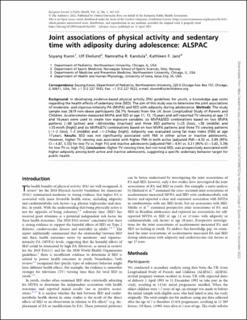| dc.contributor.author | Kwon, Soyang | |
| dc.contributor.author | Ekelund, Ulf | |
| dc.contributor.author | Kandula, Namratha R. | |
| dc.contributor.author | Janz, Kathleen F. | |
| dc.date.accessioned | 2022-11-29T17:09:34Z | |
| dc.date.available | 2022-11-29T17:09:34Z | |
| dc.date.created | 2022-09-08T11:01:23Z | |
| dc.date.issued | 2022 | |
| dc.identifier.citation | European Journal of Public Health. 2022, 32(3), Side 347-353. | en_US |
| dc.identifier.issn | 1101-1262 | |
| dc.identifier.uri | https://hdl.handle.net/11250/3034842 | |
| dc.description | This is an Open Access article distributed under the terms of the Creative Commons Attribution License (https://creativecommons.org/licenses/by/4.0/), which permits unrestricted reuse, distribution, and reproduction in any medium, provided the original work is properly cited. | en_US |
| dc.description.abstract | Background: In developing evidence-based physical activity (PA) guidelines for youth, a knowledge gap exists regarding the health effects of sedentary time (SED). The aim of this study was to determine the joint associations of moderate- and vigorous-intensity PA (MVPA) and SED with adiposity during adolescence.
Methods: The study sample was 2619 non-obese participants (56.7% female) from the UK Avon Longitudinal Study of Parents and Children. Accelerometer-measured MVPA and SED at age 11, 13, 15 years and self-reported TV viewing at age 13 and 16 years were used to create two exposure variables: six MVPA&SED combinations based on two MVPA patterns [≥60 (active) and <60 min/day (inactive)] and three SED patterns [≈25 (low), ≈30 (middle) and ≈35 min/h (high)] and six MVPA&TV combinations based on two MVPA patterns and three TV viewing patterns [<1–2 (low), 1–2 (middle) and >1–2 h/day (high)]. Adiposity was evaluated using fat mass index (FMI) at age 17 years.
Results: SED was not significantly associated with FMI in either active or inactive adolescents. However, higher TV viewing was associated with higher FMI in both active [adjusted FMI = 4.53 vs. 5.09 (95% CI = 4.87, 5.33) for low TV vs. high TV] and inactive adolescents [adjusted FMI = 4.91 vs. 5.21 (95% CI = 5.02, 5.39) for low TV vs. high TV].
Conclusions: Higher TV viewing time, but not total SED, was prospectively associated with higher adiposity among both active and inactive adolescents, suggesting a specific sedentary behavior target for public health. | en_US |
| dc.language.iso | eng | en_US |
| dc.subject | accelerometers | en_US |
| dc.subject | adolescent | en_US |
| dc.subject | alspac study | en_US |
| dc.subject | child | en_US |
| dc.subject | guidelines | en_US |
| dc.subject | lack of exercise | en_US |
| dc.subject | obesity | en_US |
| dc.subject | parent | en_US |
| dc.subject | physical activity | en_US |
| dc.subject | public health medicine | en_US |
| dc.subject | self-report | en_US |
| dc.title | Joint associations of physical activity and sedentary time with adiposity during adolescence: ALSPAC | en_US |
| dc.type | Peer reviewed | en_US |
| dc.type | Journal article | en_US |
| dc.description.version | publishedVersion | en_US |
| dc.rights.holder | © The Author(s) 2022 | en_US |
| dc.source.pagenumber | 347-353 | en_US |
| dc.source.volume | 32 | en_US |
| dc.source.journal | European Journal of Public Health | en_US |
| dc.source.issue | 3 | en_US |
| dc.identifier.doi | 10.1093/eurpub/ckac023 | |
| dc.identifier.cristin | 2049839 | |
| dc.description.localcode | Institutt for idrettsmedisinske fag / Department of Sports Medicine | en_US |
| cristin.ispublished | true | |
| cristin.fulltext | original | |
| cristin.qualitycode | 1 | |
